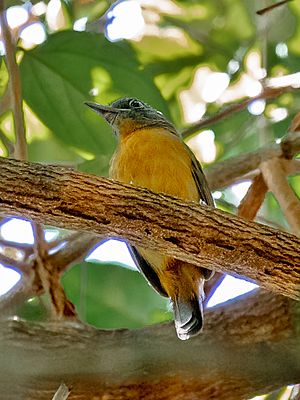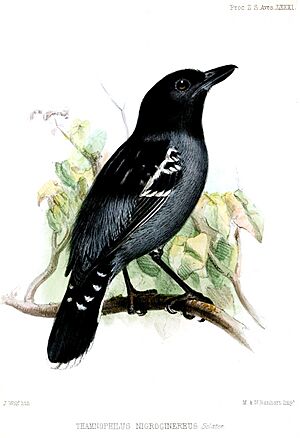Blackish-grey antshrike facts for kids
Quick facts for kids Blackish-grey antshrike |
|
|---|---|
 |
|
| A female blackish-grey antshrike at Anavilhanas National Park, Novo Airão, Amazonas, Brasil | |
| Conservation status | |
| Scientific classification | |
| Genus: |
Thamnophilus
|
| Species: |
nigrocinereus
|
 |
|
The blackish-grey antshrike is a cool bird. It belongs to a group of birds called antbirds. These birds are part of the Thamnophilidae family.
You can find this bird in several South American countries. These include Brazil, Colombia, Venezuela, and eastern French Guiana. It also lives in a small river area in northeast Bolivia.
This antshrike likes to live in certain places. Its natural homes are warm, wet forests. It also likes swamps in tropical or subtropical areas. The bird gets its name "blackish-grey antshrike" from its color. Its blackish-grey feathers help tell it apart from other antshrikes.
About Its Name and Family
The blackish-grey antshrike has a scientific name. It is Thamnophilus nigrocinereus. An English zoologist named Philip Sclater first described this bird. He did this in 1855. Giving animals scientific names helps scientists study them.

Where It Lives
The blackish-grey antshrike lives in many places. It is found in Brazil's southeastern Amazon Basin. You can also see it along the Amazon River itself.
It lives northwards from the Amazon's mouth. This includes the far eastern parts of French Guiana. It also lives in Brazil's northeast state of Amapá.
Its range goes slightly southwest in Brazil. This area is about 1000 to 1400 kilometers wide. Its eastern edge is the last 950 kilometers of the Tocantins River. To the west, its home is near the Madeira River. It goes upstream into northeast Bolivia for about 75 kilometers. This area is where the Madeira and Guaporé Rivers meet.
To the east, the bird's home covers the river areas of the Tapajós, Xingu River, and lower Tocantins River. This whole area is about 3500 kilometers wide.
The bird's home also stretches northwest from the Amazon River. It goes upstream along the Rio Negro. This river acts like a path for the birds. They go into eastern and central Colombia. They also go east and north into central and southern Venezuela. This includes the Orinoco River area. In the central Orinoco area, it stays close to the river. It does not go far north from the river. You also won't find it in the lower third of the river, closer to the Caribbean Sea.
See also
 In Spanish: Batará ceniciento para niños
In Spanish: Batará ceniciento para niños


